
In this lesson on ratios, students explore how ratios can be used to demonstrate rates by exploring proportional relationships.
- Subject:
- Mathematics
- Material Type:
- Interactive
- Lesson
- Provider:
- Nearpod
- Date Added:
- 08/07/2023


In this lesson on ratios, students explore how ratios can be used to demonstrate rates by exploring proportional relationships.

In this lesson, students will learn how to perform operations in scientific notation.
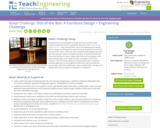
Student teams are challenged to design and build architecturally inspired cardboard furniture, guided by the steps of the engineering design process. They cultivate their industrial engineering and design skills to design furnishings that meet functional, aesthetic and financial requirements. Given constraints that include limited building materials and tools, groups research architectural styles and period furnishings. The teams brainstorm ideas, make small-scale quick prototypes, then make detailed plans and create full-scale prototypes of their best solutions. The full-size prototypes are evaluated by peer critique for aesthetic alignment to the targeted architectural style and tested for functionality. After final refinements, teams present their concepts and display their final prototype furnishings in an exhibition.
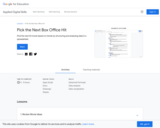
Find the next hit movie based on trends by structuring and analyzing data in a spreadsheet. Time to complete: 6-9 hours
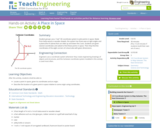
Student groups use a "real" 3D coordinate system to plot points in space. Made from balsa wood or wooden dowels, the system has three axes at right angles and a plane (the XY plane) that can slide up and down the Z axis. Students are given several coordinates and asked to find these points in space. Then they find the coordinates of the eight corners of a box/cube with given dimensions.

Module 1 sets the stage for expanding students' understanding of transformations by exploring the notion of linearity. This leads to the study of complex numbers and linear transformations in the complex plane. The teacher materials consist of the teacher pages including exit tickets, exit ticket solutions, and all student materials with solutions for each lesson in Module 1.

The students will be taking a summative assessment about rates and unit rates.

This interactive activity adapted from the Wisconsin Online Resource Center challenges you to plan, measure, and calculate the correct amount of roofing material needed to reroof a house.

College-level electrical engineering textbook starting from the Coulomb-Lorentz force law on a point charge. Sample problems that reinforce the content are found at the end of each chapter. Includes downloadable excerpts of the textbook and a solutions manual.
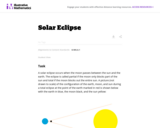
Total solar eclipses are quite rare, so much so that they make the news when they do occur. This task explores some of the reasons why. Solving the problem is a good application of similar triangles

Solving percents using real world scenarios.
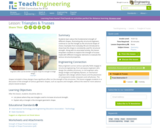
Students learn about the fundamental strength of different shapes, illustrating why structural engineers continue to use the triangle as the structural shape of choice. Examples from everyday life are introduced to show how this shape is consistently used for structural strength. Along with its associated activity, this lesson empowers students to explore the strength of trusses made with different triangular elements to evaluate the various structural properties.
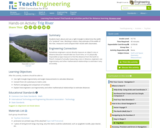
Students learn about and use a right triangle to determine the width of a "pretend" river. Working in teams, they estimate of the width of the river, measure it and compare their results with classmates.

This video segment from Regents Review 2.0 uses a trigonometry equation to determine the height of a flagpole located in front of the school.
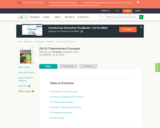
CK-12 Foundation's Trigonometry FlexBook is an introduction to trigonometry for the high school student. It includes chapters on graphs of trigonometric functions, trigonometric identities, inverse trigonometric functions, triangles and vectors, and the polar system.
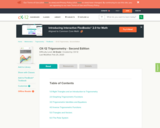
CK-12 Foundation's Trigonometry FlexBook is an introduction to trigonometry for the high school student. Topics include: Trigonometric Identities & Equations, Circular Functions, and Polar Equations & Complex Numbers.
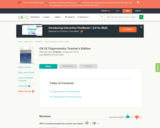
CK-12 Trigonometry Teacher's Edition provides tips and common errors for teaching CK-12 Trigonometry Student Edition. The solution and assessment guides are available upon request.

Student centered activities based on rates and unit rates!
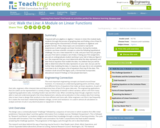
Prepared with pre-algebra or algebra 1 classes in mind, this module leads students through the process of graphing data and finding a line of best fit while exploring the characteristics of linear equations in algebraic and graphic formats. Then, these topics are connected to real-world experiences in which people use linear functions. During the module, students use these scientific concepts to solve the following hypothetical challenge: You are a new researcher in a lab, and your boss has just given you your first task to analyze a set of data. It being your first assignment, you ask an undergraduate student working in your lab to help you figure it out. She responds that you must determine what the data represents and then find an equation that models the data. You believe that you will be able to determine what the data represents on your own, but you ask for further help modeling the data. In response, she says she is not completely sure how to do it, but gives a list of equations that may fit the data. This module is built around the legacy cycle, a format that incorporates educational research feindings on how people best learn.

Students will use design thinking, creativity, problem-solving, and procedural skills to create a wearable soft circuit. This activity does not use a computer. The LilyPad E-Sewing ProtoSnap Kit used in this activity helps students develop a STEM mindset. It is important to allow students to work through the process as independently as possible with the facilitator acting only as a guide.
Estimated time required: 2 class periods.
Technology required for this lesson: Electronics Kit.